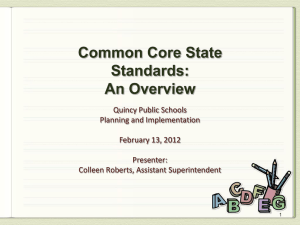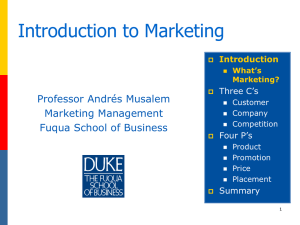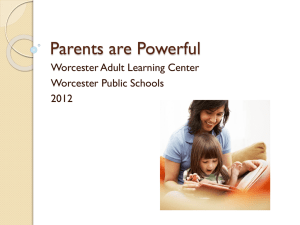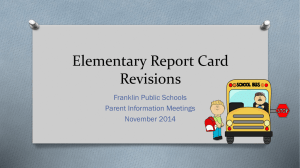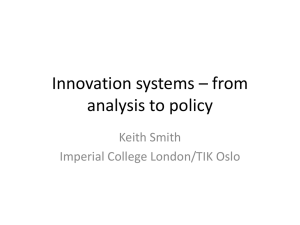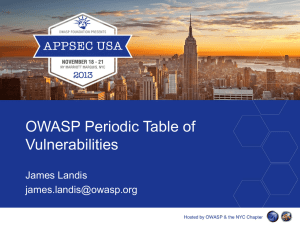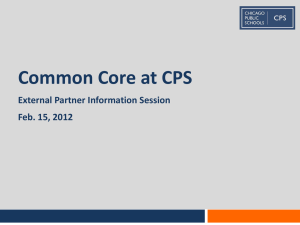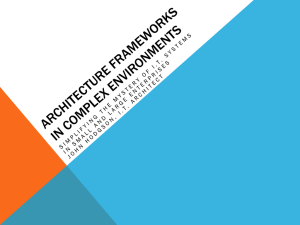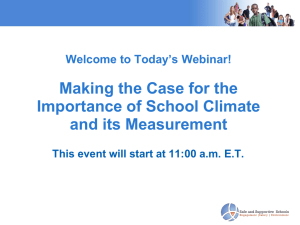Transitioning to the new MA Curriculum Frameworks in ELA/Literacy
advertisement
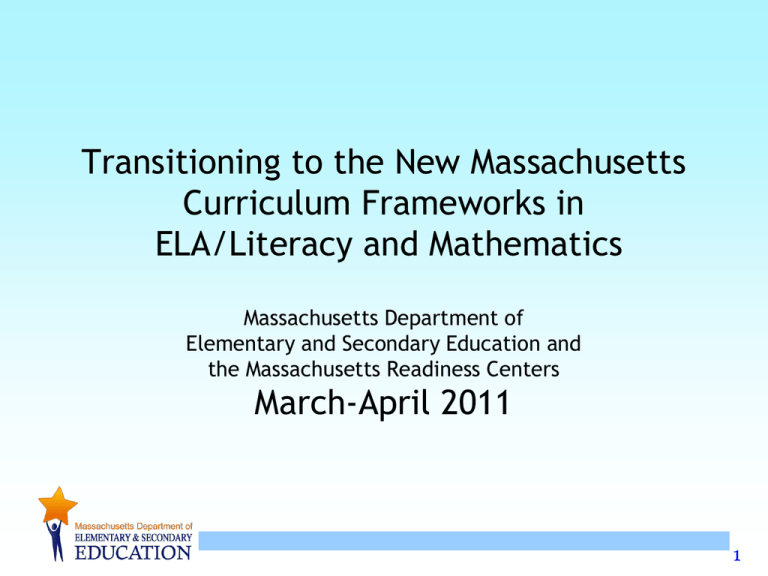
Transitioning to the New Massachusetts Curriculum Frameworks in ELA/Literacy and Mathematics Massachusetts Department of Elementary and Secondary Education and the Massachusetts Readiness Centers March-April 2011 1 Topics New ELA/Literacy & Math Curriculum Frameworks Incorporating the Common Core State Standards MCAS • • • • Development & Adoption Intent and Key Features Implementation Timeline Implementation Supports • Transitioning MCAS to the New Frameworks 2 Development and Adoption of the New Curriculum Frameworks Incorporating the Common Core Standards Spring 2009 Summer 09-Spring 10 July 2010 • Governor and Commissioner sign MOU • DESE Staff & Local Educators Provide Feedback to Drafts • DESE & MBAE Studies • Development Begins • Final Version of CCSS completed June 2010 • BESE Adopts CCSS, with Option for Additions Fall 2010 December 2010 • DESE/DEEC BESE Adopts Identify New Frameworks Additional Incorporating Standards CCSS • Public Comment Solicited on Additions BEEC Adopts Pre-K Standards 3 Where Have the Common Core State Standards Been Adopted? Alabama, Arkansas, Arizona, California, Colorado, Connecticut, Delaware, the District of Columbia, Florida, Georgia, Hawaii, Idaho, Illinois, Indiana, Iowa, Kansas, Kentucky, Louisiana, Maryland, Massachusetts, Michigan, Minnesota (ELA/Literacy only), Mississippi, Missouri, Nevada, New Hampshire, New Jersey, New Mexico, New York, North Carolina, Ohio, Oklahoma, Oregon, Pennsylvania, Rhode Island, South Carolina, South Dakota, Tennessee, U.S. Virgin Islands, Utah, Vermont, West Virginia, Wisconsin, Wyoming 4 Primary Intent The New ELA/Literacy and Math Curriculum Frameworks, comprised primarily of the Common Core State Standards, were written explicitly to define the knowledge and skills that students must master to be college and career ready by the end of high school. 5 What is the College and Career Ready Threshold In Each of the Frameworks? ELA/Literacy Mathematics • In the ELA Framework there is a set of broad, College and Career Ready Standards for each of the areas of reading, writing, speaking/listening, and language. They anchor grade-specific standards in each of those areas. • The CCR Standards, working in tandem with the high school (9-12) standards, define the CCR threshold. • In the Mathematics Framework the CCR threshold is comprised of the high school standards that are not marked “+”. • Mastering those standards would prepare a student for a first-year, college creditbearing math course such as college algebra. • Mastering high school standards marked “+” would prepare a student for more advanced math courses than college algebra. 6 Key Features New ELA/Literacy Framework • Promotes students’ ability to read and comprehend increasingly complex text and write to a source – CCR Reading Standard 10: Read and comprehend complex literary and informational text independently and proficiently. – CCR Writing Standard 9: Draw evidence from literary and informational texts to support analysis, reflection, and research. • Promotes the idea that teaching literacy skills is not just the job of the English teacher – Literacy standards for History and Social Studies, Science, and Technical Subjects. • Promotes the development of strong research skills – Key to college and career readiness are research and media skills. These skills are blended throughout the standards, rather than treated in a separate section. 7 Key Features New Mathematics Framework The new standards support improved curriculum and instruction due to increased: – FOCUS, via critical areas at each grade level – COHERENCE, through carefully developed connections within and across grades – CLARITY, with precisely worded standards that cannot be treated as a checklist – RIGOR, including a focus on College and Career Readiness and Standards for Mathematical Practice throughout Pre-K-12 8 Transitioning Curriculum and Instruction to the New Frameworks Timeline for Preschools, Districts, Colleges and Universities 2010-2011 2011-2012 2012-2013 Initial Planning Partial Implementation Near Full Implementation Build awareness and identify what needs to change and how it will be changed Continue planning and make changes in targeted grades, subjects, and courses Implement balance of changes 9 Transitioning Curriculum and Instruction to the New Standards How the DESE and Readiness Centers will Help 2010-2011 Initial Planning 2011-2012 Partial Implementation 2012-2013 Near Full Implementation • Orientations • Crosswalks • Modules • RTTT $$$ •Targeted support • Model Curriculum • PD courses • RTTT $$$ • Targeted support • Model Curriculum • Formative Assessment System • PD courses • RTTT $$$ •Targeted support 10 Other Support for the Transition • Foundations Bill and Melinda Gates, Carnegie, Annie Casey, Pearson • Non Profits Council of Chief State School Officers, Achieve, College Board, National Governors Association, education associations; in Massachusetts, the Readiness Centers, public and private colleges and universities, and organizations such as Strategies for Children, the MA Business Alliance for Education, and the Rennie Center • USED Race to the Top Grants, Striving Readers Comprehensive Literacy Grant Program, ESEA reauthorization • Assessment Consortia Partnership for the Assessment of Readiness for College and Career (PARCC) and Smarter Balanced • Unions American Federation of Teachers/ American Educator, Winter 2010/2011 11 Transitioning MCAS to the New Standards Objective: (1) Fairness (2) Maintain Trendline 2010-2011 Initial Planning 2011-2012 Partial Implementation 2012-2013 Near Full Implementation MCAS No changes based on former Frameworks MCAS Focus on standards common to former and new Frameworks MCAS Focus on standards common to former and new Frameworks Will also assess selected standards from the former Frameworks not included in the new Frameworks* Will also assess selected standards from new Frameworks not included in former Frameworks* * This transition plan applies to grades 3 to 8; the transition plan for grade 10 is being determined. In spring 2011, ESE will release a list of the standards that will be assessed on the 2012 MCAS. 12 Looking Ahead • Preschools, districts and educator preparation programs should have curriculum and instruction fully aligned to the new frameworks by the beginning of the 2013-2014 school year • MCAS in grades 3-8 will be based exclusively on the new frameworks in spring 2014 • Pending its successful development, Massachusetts will transition to PARCC for ELA and math in 2014-2015 • Similar standards development process for science and engineering, with standards expected in mid-2012 and a transition period to follow • Standards for English Language Learners, Comprehensive Health, History and Social Science, the Arts, and Foreign Languages will be added to the revision cycle 13 Continuing Updates • The 2011 Frameworks and crosswalks are available at http://www.doe.mass.edu/candi/commoncore • Please check this site regularly for additional resources and updates on professional development. 14
